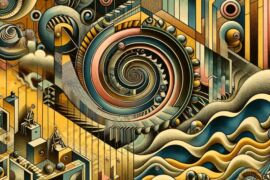When it comes to staying the course with your investment portfolio the biggest enemy is staring right back at you when you look into the mirror.
That’s right.
It’s you.
Nah.
That can’t be possible.
Actually it entirely is.
But it’s not your fault.

The skillset required to be a good investor is just not built naturally into our DNA.
When your house is burning down you grab the fire extinguisher.
Being chased by a lion. Run like heck!
If you’re sputtering out of control with bad habits and behaviours you take the necessary steps to modify things.
In other words, you take action.
But when it comes to investing the ability to not take action is far more crucial.
Inaction vs action.
Sometimes a #FinTwit tweet inspires a blog post.
This is once again the case.
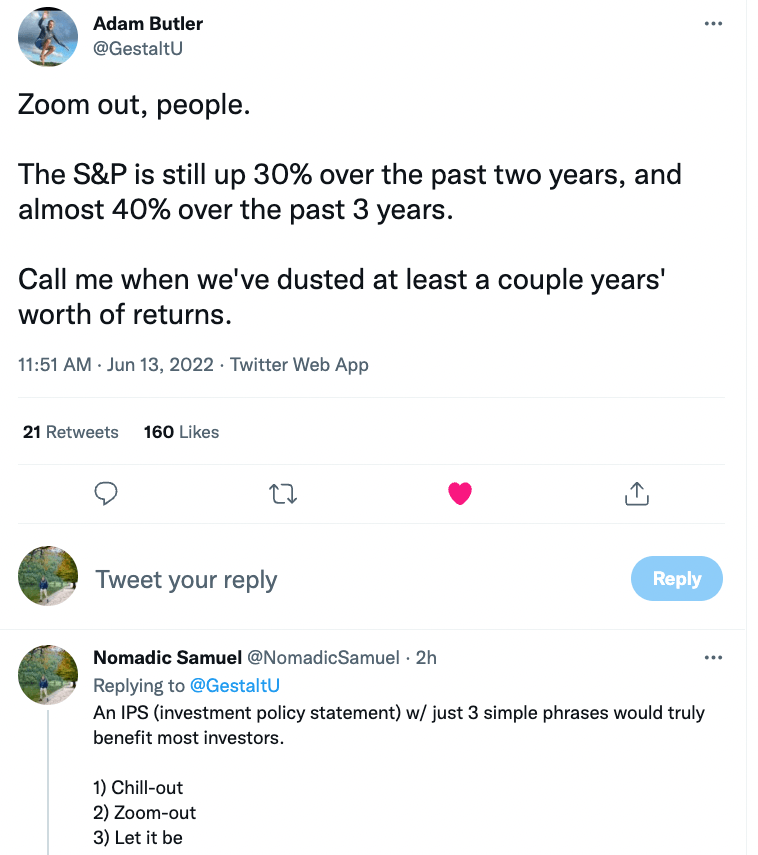
I have both Adam Butler, who has been a guest on “investing legends” interview series and Dominant Portfolio to thank for getting the ball rolling over here.

Investment Statement Policy

A personal investment statement and action plan is needed in order to protect you from yourself.
A contract that stipulates how you’re going to behave when markets are inevitably volatile, your portfolio is experiencing drawdowns and your patience is running thin.
Who ya gonna call?
Not Ghostbusters.
You’re going to refer to your ISP.
Oh, I’ve clearly outlined what I’m supposed to do when event X, Y and Z is happening.
Okay.
Whew.
But before you can write such a plan you first need to prepare a portfolio that suits your investment goals, provides adequate diversification and prevents you from taking on too much risk.
This is a highly subjective matter.
No one shoe fits each investor the same.
And before you can assess whether or not you’ve got the right strategy you need to educate yourself on investor psychology and also be aware of your natural impulses and tendencies.
This is no easy task.
Self awareness is tricky.
It has to be acquired either through knowledge and/or a system that prevents you from making irrational short-term decisions based on narrative, recent macro events and normal levels of volatility experienced in the markets.
Certain people have the personality, disposition and self-awareness through enough experience and education to become disciplined investors.
Others, no matter how many books they read on behavioural finance, podcasts discussing the subject, and/or exposure to enough infamous Warren Buffet and Charlie Munger quotes cannot overcome the temptation to muck about a perfectly sensible investing plan and well thought out portfolio.
I’ve been meaning to write on this very subject since starting the blog but I’ve been admittedly sidetracked by pursuing the picture perfect portfolio.
My bad.
Which, by the way, is merely the icing on the cake when it comes to transforming into a successful investor.
No sensible investment plan survives the cockpit eject button.
Even the best of the best portfolios, from a returns meets risk meets diversification standpoint, require a full commitment to the strategy over decades to bear its intended fruits.
Yet most investors think in terms of days, weeks, months and maybe a year or two at best as opposed to three, five, ten, twenty year time horizons.
Short-term thinking is pervasive.
Long-term thinking is what is required.
So let’s get back on track here with a Personal Investment Statement.
I’ve been preparing a comprehensive one for a while now, that reads more like a white paper, so you’ll want to grab a coffee and a snack or a large bowl of popcorn and a soda because this is going to take a little while to read and digest.
Here it is.

Zoom Out. Chill Out. Let It Be.

Zoom out.
Chill out.
Let it be.
Oh, that’s a clever title.
How about the body?
One more time here.
Zoom out.
Chill out.
Let it be.
What the heck?!?!?!
Yeah, that’s the full plan.
At least from the a behavioural and psychological standpoint.
Once you’ve dialled in a portfolio from an asset allocation perspective, decided on a rebalancing strategy, figured out what to do when it comes to contributions/distributions the only thing left is the following:
Zoom out.
Chill out.
Let it be.
That’s overly simplistic, no?
Amateur, even?
Maybe.
But what doesn’t it cover?
Let’s unpack that a little bit.

Zoom Out Investment Statement Policy

What does it mean to zoom out as an investor?
It’s the ability to see the big picture.
You see as investors we’re constantly being bombarded by negative news stories, doomsday scenario macro events and quite often drawdowns within our portfolio.
It’s easy to get caught up in the moment and think that recent events are going to continue in perpetuity.
But they’re not.
They never have and they never will.
Booms lead to busts.
Busts lead to booms.
Bears follow raging bull markets.
Bull markets are borne out of the Bear market’s despair.
But how do you learn to zoom out as an investor?
You have to be willing to see the big picture.
I’ve found personally zooming out with various scenarios, which you can construct on portfolio visualizer, really helps in this given area.
Let’s use US Micro-Caps as an example.
They’re one of the most volatile style box equity classes you’ll find with higher historical returns and associated higher levels of risk (standard deviation).
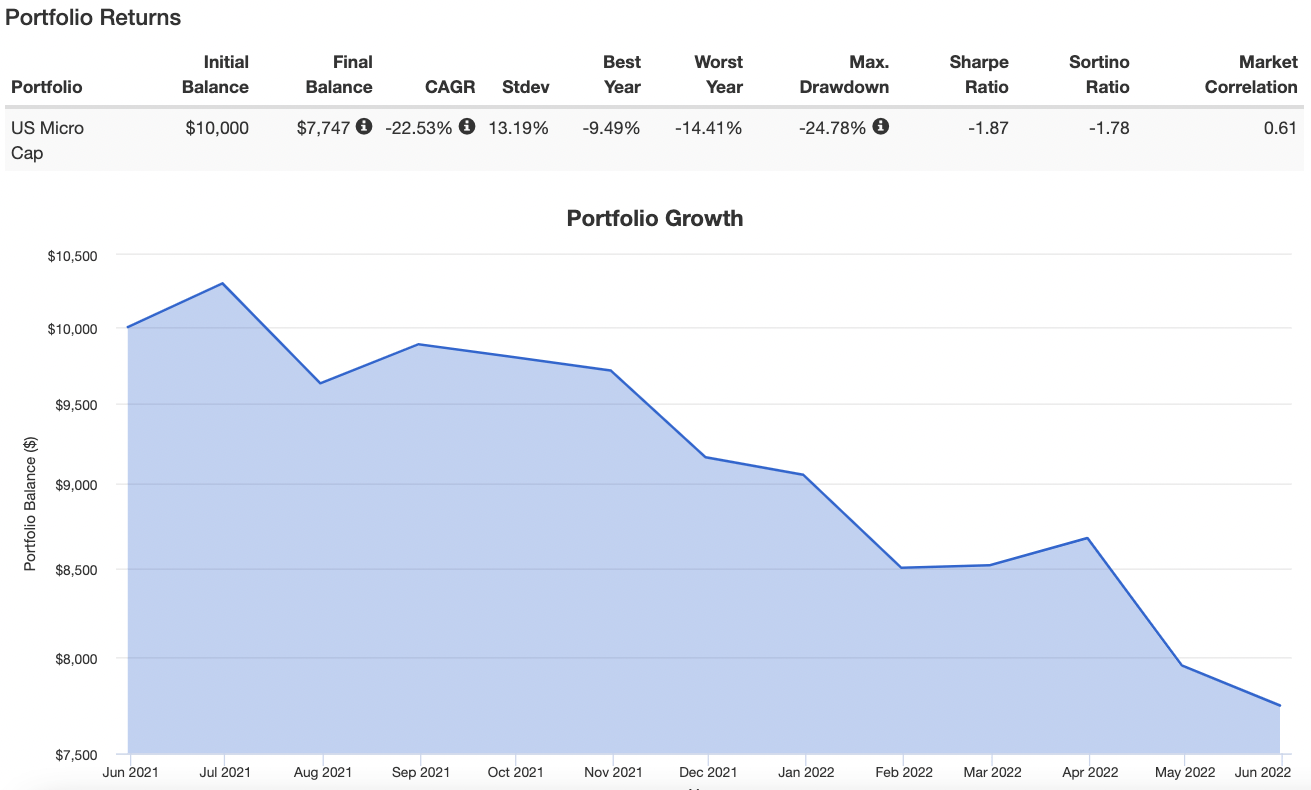
Let’s zoom in!
Yikes!
The sky is falling!
You’ve committed to a US micro-cap strategy last June and it has been nothing but a pain game ever since.
Down freakin’ -22.53%.
Ah man, I’m an idiot.
Clearly I bought at the top.
No.
Even worse.
This strategy simply doesn’t work anymore.
What was I thinking investing in micro-caps?
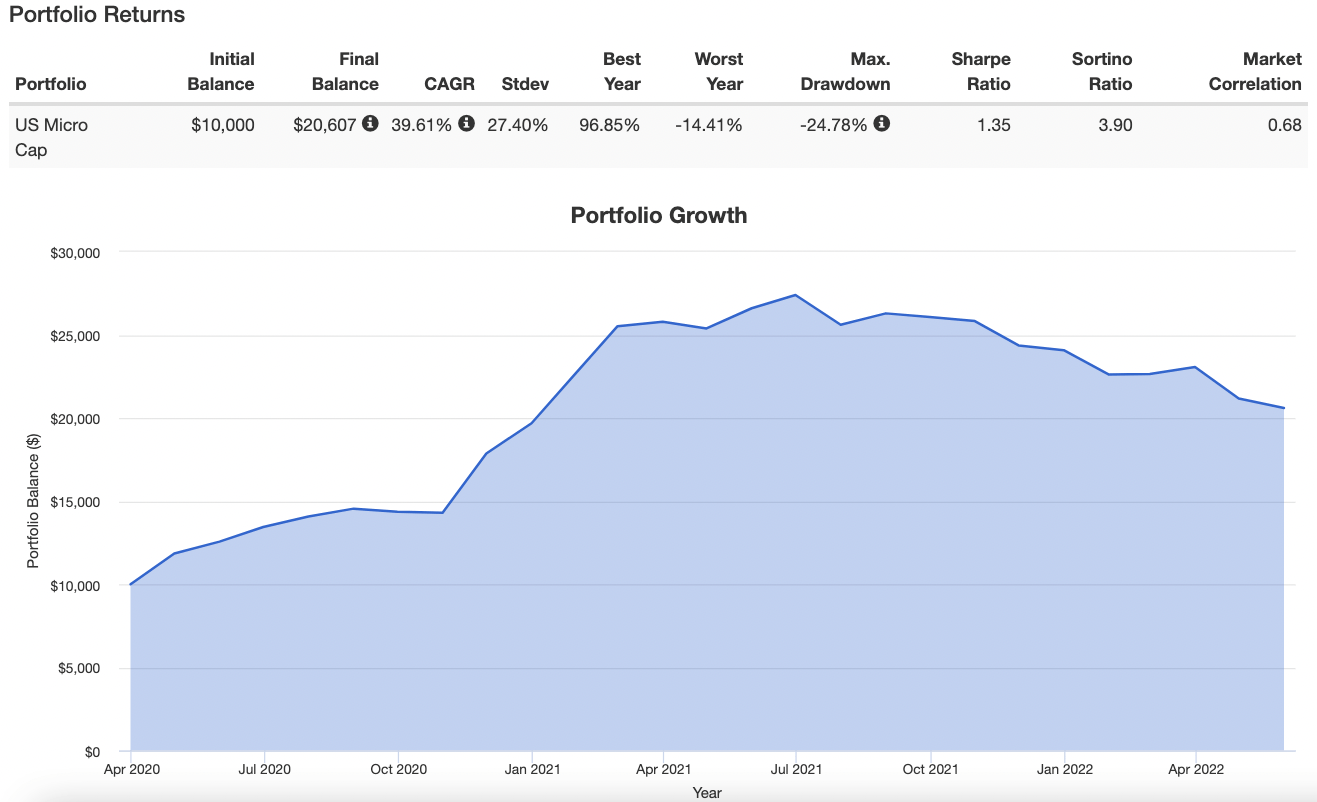
Let’s zoom out – just a tad!
Oh my!
This looks a little more encouraging.
From the perspective of two years worth of returns I’m not such a fool after-all.
Check out the 39.61% CAGR!
Fool!
Ha!
In fact, I’m a genius.
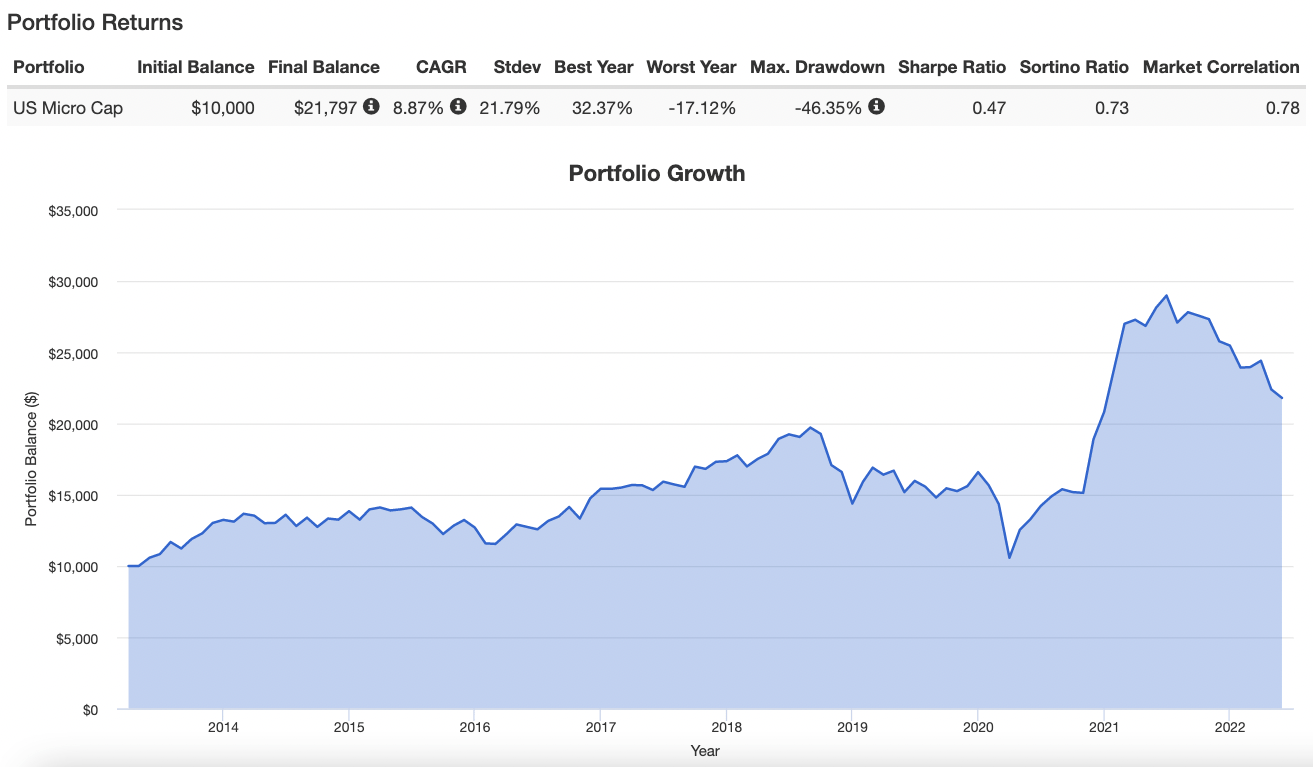
Now we’ll zoom out even further!
How about the 10 year returns from this asset class?
Not too shabby at all.
A solid 8.87 CAGR.
Jeez Eloise, this seems to be not too bad of an equity strategy now that I think about it.
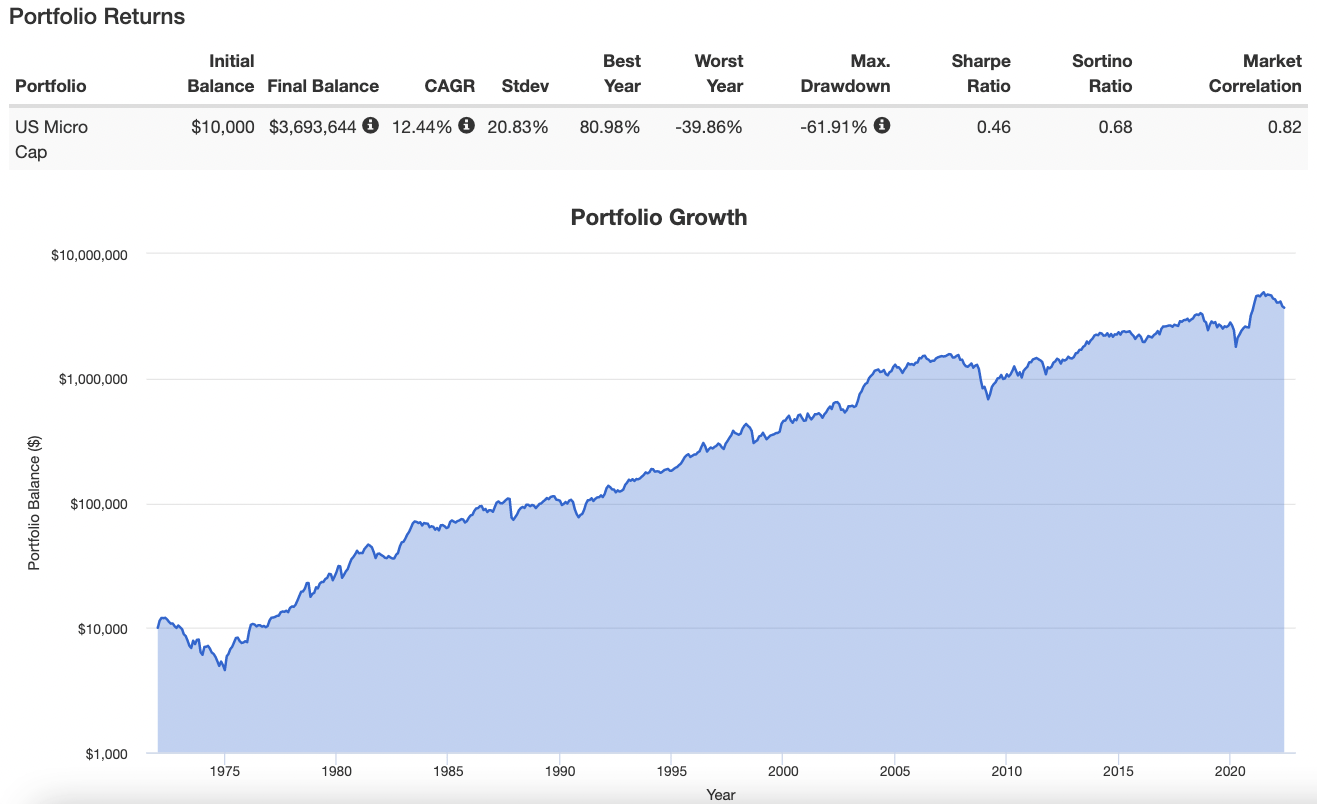
Zooming out entirely for the big picture!
Well, check this out.
Holding on for over 50 years would mean a 12.44% CAGR.
$10,000 hypothetical dollars would have turned into $3,693,644 (before fees and taxes).
Zooming out and seeing the big picture is crucial as an investor.
Short-term results are volatile.
Long-term results are not.
The great advance rewards investors who can just zoom out and get out of the way.
Just hold on and get out of the way with your sensible strategy, turns out to be, the best thing an investor can do.

Chill Out Investment Statement Policy

Bringing emotions into the arena of investment decisions is a recipe for disaster.
Consider what Charlie Munger had to say on the subject:
“If you’re not willing to react with equanimity to a market price decline of 50% two or three times a century … you deserve the mediocre result you’re going to get compared to the people who do have the temperament, who can be more philosophical about these market fluctuations.”
Let’s define equanimity: “Mental calmness, composure, and evenness of temper, especially in a difficult situation.” (Source: Oxford Dictionary)
Sounds like a clever way of describing “chilling out” don’t ya think?
What does Warren Buffet have to say on the subject of being able to “chill out” when it comes to your investment’s recent performance?
“The stock market is a transfer of wealth from the patient to the impatient.”
Oh, that one cuts like a knife.
No beating around the bush from Mr. Buffet when it comes to clear and concise advice.
Yet, most investors ignore the greats like Munger and Buffet and instead indulge the four Horsemen of the Apocalypse of staying the course:
- Recency bias
- Loss aversion
- Narrative based investing and suffer from
- FOMO (fear of missing out)
Yeah, those four things will screw up any investment plan.
How does one avoid not succumbing to all of these tempting ways to muck things up?
Basically, by just chilling out.
How do you increase your chances of chilling out?
Here are three suggestions:
- Not checking your portfolio very often
- Avoiding the news (especially when it is related to day to day market performance)
- Realizing that even the best portfolios, from a maximum diversification standpoint, only have a success ratio of 80 to 90%
Thus, you’ve got to be prepared as an investor for negative years.
That’s even with a Risk Parity Portfolio or Ray Dalio All Weather Portfolio.
Chilling out means also being able to integrate the “Zooming Out” into the equation.
If you see the big picture the odds are on your side.
Chill out.
Be more like Spock and less like Captain Kirk.
Think of a Sloth as your spirit animal.
Sloths aren’t lazy – their slowness is a survival skill.
Your portfolio also survives quite nicely by being more sloth-like, eh?
Let It Be Investment Policy Statement
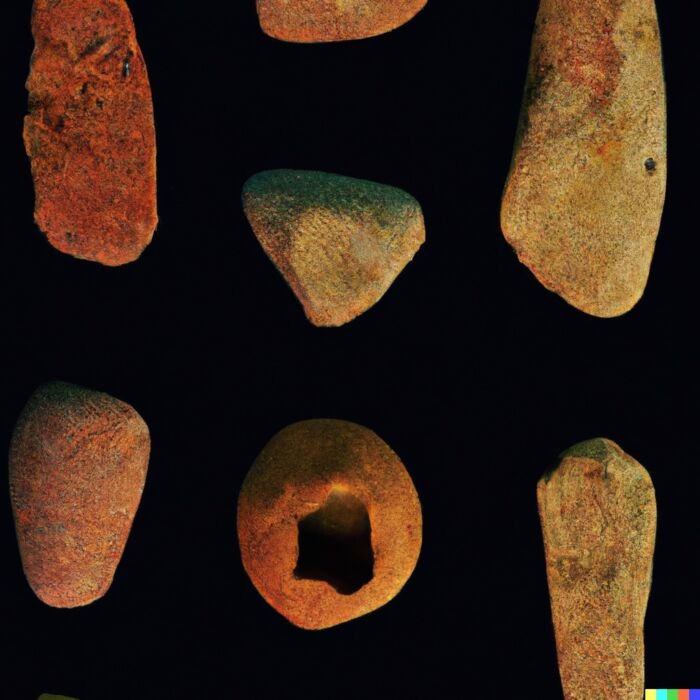
It was great to see that a friend on Twitter, Dominant Portfolio, was thinking the same thing I was.
There is no better song to represent not mucking up or screwing up a portfolio than the Beatles classic: “Let It Be”
When I find myself in times of trouble
Mother Mary comes to me
Speaking words of wisdom
Let it be
And in my hour of darkness
She is standing right in front of me
Speaking words of wisdom
Let it be
Let is be, let it be
Let it be, let it be
Whisper words of wisdom
Let it be
So when is your darkest hour when it comes to investing?
Likely when kaka is hitting the fan.
So what should we do in that situation?
Let it be.
Let your portfolio be as it is.
You see loss aversion is twice as powerful of an emotion than when things are working out well for you as an investor.
We’re naturally, as humans trying to survive in a complex world, more attuned to what is going wrong than what is going right.
Yet, capitulation and selling your assets or abandoning a well thought out plan when things aren’t working out is exactly the wrong thing to do.
Why?
Because we’d be turning hypothetical losses into real ones.
If you don’t sell 1000 units of fund $XYZ then you still own 1000 units of $XYZ even while it’s experiencing a drawdown.
So long as you don’t sell it and allow it to recover you’ve lost nothing.
It’s only when you panic, and you don’t let it be, that you turn a hypothetical loss into a real one.
One of the ways as investors, we can better prepare for drawdowns, is to own a portfolio of diversified strategies and uncorrelated asset classes.
A 1-2-3 approach to investing where we own stocks, bonds and alternatives.
Portfolios such as the Risk Parity Portfolio, the Ray Dalio All Weather Portfolio, the Adaptive Asset Allocation Portfolio, the Cockroach Portfolio, Return Stacked 60/40 Portfolio and the Picture Perfect Portfolio are prepared for all economic outcomes.
Let’s consider the following as a quick example.
The Risk Parity Portfolio vs a US Total Stock Market only Portfolio.
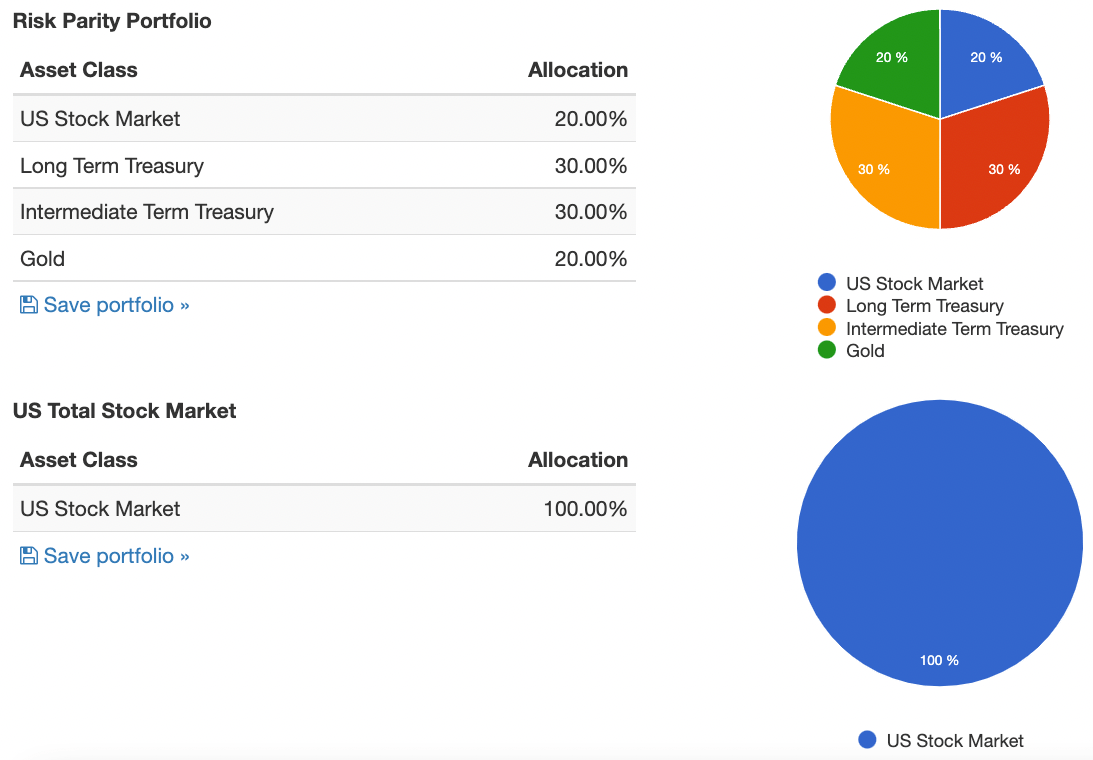
20% US TOTAL STOCK MARKET
30% LONG-TERM TREASURY
30% INTERMEDIATE-TERM TREASURY
20% GOLD
100% US TOTAL STOCK MARKET
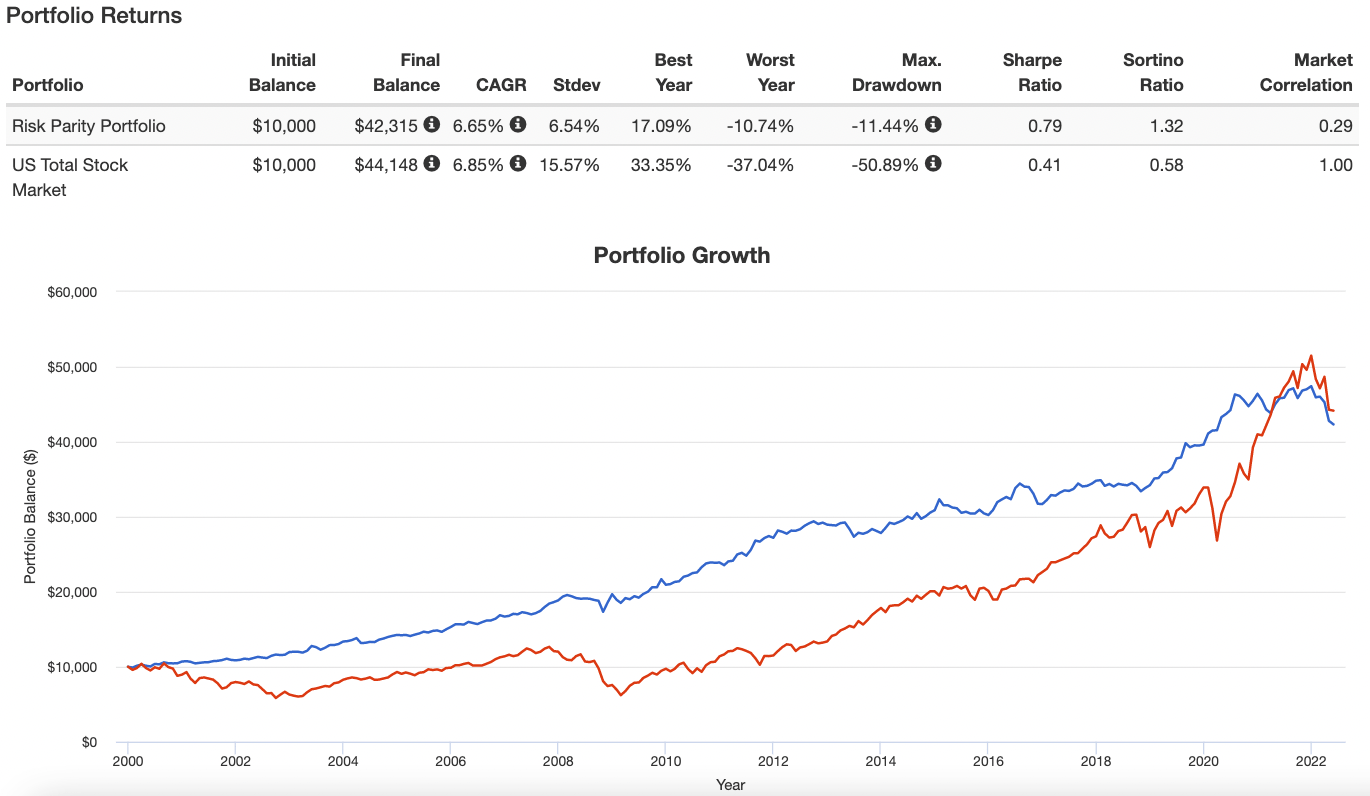
What we notice is that the Risk Parity Portfolio and the US Total Stock Market Portfolio get roughly the same results long-term but what a difference in the ride!
One is smooth and steady.
The other is a rollercoaster.

The annual returns paints a more vivid picture.
The Risk Parity Portfolio is up more often than it is down. And when it is down it is not down by much.
The US Total Stock Market has much wilder lows and highs including rough patches in the early 2000s, 2008 and 2022.

And from a sequence of returns risk Roll Period, it’s much easier to “Let it Be” when your worst case scenario is a 1 year low versus a 10 year low!
Thus, careful portfolio construction from an asset allocation standpoint is one of the key components of enhancing your odds of “Letting it be” through the thick and thin of it all.

Nomadic Samuel Final Thoughts

So we’ve hit over 2000 words!
Quite a lengthy post for such a short IPS (Investment Policy Statement).
One more time:
Zoom Out.
Chill Out.
Let It Be.
Do you agree?
Important Information
Comprehensive Investment Disclaimer:
All content provided on this website (including but not limited to portfolio ideas, fund analyses, investment strategies, commentary on market conditions, and discussions regarding leverage) is strictly for educational, informational, and illustrative purposes only. The information does not constitute financial, investment, tax, accounting, or legal advice. Opinions, strategies, and ideas presented herein represent personal perspectives, are based on independent research and publicly available information, and do not necessarily reflect the views or official positions of any third-party organizations, institutions, or affiliates.
Investing in financial markets inherently carries substantial risks, including but not limited to market volatility, economic uncertainties, geopolitical developments, and liquidity risks. You must be fully aware that there is always the potential for partial or total loss of your principal investment. Additionally, the use of leverage or leveraged financial products significantly increases risk exposure by amplifying both potential gains and potential losses, and thus is not appropriate or advisable for all investors. Using leverage may result in losing more than your initial invested capital, incurring margin calls, experiencing substantial interest costs, or suffering severe financial distress.
Past performance indicators, including historical data, backtesting results, and hypothetical scenarios, should never be viewed as guarantees or reliable predictions of future performance. Any examples provided are purely hypothetical and intended only for illustration purposes. Performance benchmarks, such as market indexes mentioned on this site, are theoretical and are not directly investable. While diligent efforts are made to provide accurate and current information, “Picture Perfect Portfolios” does not warrant, represent, or guarantee the accuracy, completeness, or timeliness of any information provided. Errors, inaccuracies, or outdated information may exist.
Users of this website are strongly encouraged to independently verify all information, conduct comprehensive research and due diligence, and engage with qualified financial, investment, tax, or legal professionals before making any investment or financial decisions. The responsibility for making informed investment decisions rests entirely with the individual. “Picture Perfect Portfolios” explicitly disclaims all liability for any direct, indirect, incidental, special, consequential, or other losses or damages incurred, financial or otherwise, arising out of reliance upon, or use of, any content or information presented on this website.
By accessing, reading, and utilizing the content on this website, you expressly acknowledge, understand, accept, and agree to abide by these terms and conditions. Please consult the full and detailed disclaimer available elsewhere on this website for further clarification and additional important disclosures. Read the complete disclaimer here.



